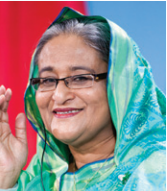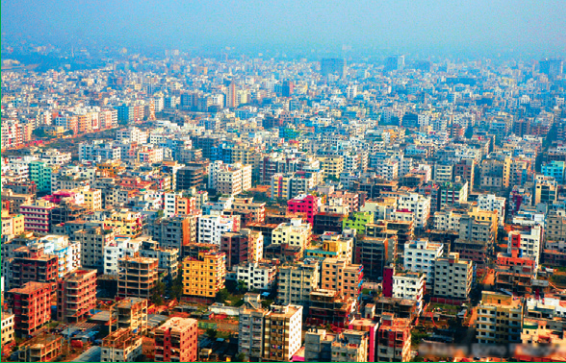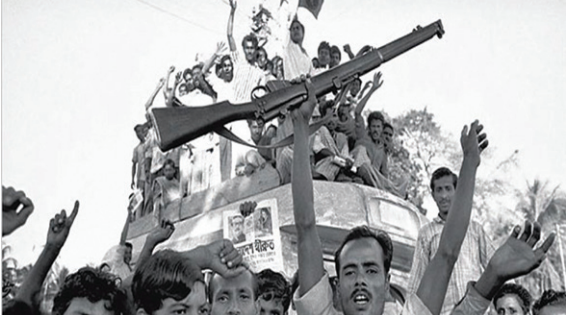2013 is the year of the election in Bangladesh. The two leading parties, Awami League and the BNP, will go head to head once again to determine who will be victorious. However, leading up to the election, Bangladesh has witnessed a number of tragic events which have their roots in party conflict. This conflict began in 1971 following the War of liberation and continues to this day. Rizwan Rahman feels that the attachment to the war is holding the country back and there is a need to rethink the role of the war in the nation’s consciousness otherwise economic progress will slow down further.
Introduction
Bangladesh has yet to celebrate its independence. There was an independence war that lasted between March 26th 1971 and ended on December 16th of the same year. There were the cheers of liberation, the jubilant cries surrounding the return of the conquering leader, Sheikh Mujibur Rahman, and the collective euphoria of having destroyed the shackles of repression. But since those halcyon days, Bangladesh’s history has been inextricably linked to the victory of 1971. The nation’s consciousness is tied to symbols of war, and rather than growing and building from the self-determination that independence imposes, Bangladesh is a country with a heart but withering arteries.
Perhaps this is a searing and wrong indictment of a country that has grown at an average of 6% in the last decade. It was once the leading supplier of jute; is the birthplace of microfinance; and is a leading provider of textiles to some of the West’s leading clothing brands. The World Bank estimates that more than 15 million people have escaped poverty through industrialisation. While still reliant on agriculture, the manufacturing and services sectors are growing, with labour participation increasing. It is still a country blighted by severe poverty, but according to Goldman Sachs, Bangladesh is part of the Next Eleven (N-11), the next group of large economies in the world (The other countries include Egypt, Indonesia, Iran, Mexico, Nigeria, Pakistan, Philippines, Turkey, South Korea, and Vietnam).
Thus, the future in some respects looks bright. But the recent troubles in Bangladesh involving electoral bickering, corruption and religious conflict reveal a country with deep internal troubles. These troubles have the potential of ruining a country whose people have shown enterprise, tenacity and resilience over the years. To progress, and avoid catastrophe, Bangladesh have to inculcate a vision that is anchored by the war of liberation in 1971, but not driven by it. Unfortunately, consecutive governments have repeatedly failed to escape the past. In this article, we explore the internal factors that may contribute to the corrosion of the country, and find that Bangladesh is a disunited country with disparate camps being set up at constant loggerheads with each other.

Electoral bickering in a troubled democracy In 1991, democracy descended upon abuses of power have been exchanged. The fraught relationship between the two ladies, and their respective parties, has spilled onto the streets. Monthly strikes are common and called by whoever the opposition party is at the time to highlight an often innocuous grievance. The strikes halt business and induce riotous behaviour on the street dragging the economy to a virtual standstill. Local press reports estimate that the strikes cost Bangladesh’s economy USD250 million per day. A 2005 United Nations Development Programme report found that during the 1990s, strikes were siphoning off 3-4 percent of the country’s annual GDP.


Democracy unwittingly encourages exaggerated criticisms, and often ad homiem attacks on the leader by the opposition. The USA, considered a model example of democracy, is fraught with
vitriolic attacks by the Republican Party on President Barack Obama and the Democratic Party, in a desperate bid to convince the electorate of the weakness of his premiership thereby, hopefully, increasing their own support base. This can stifle the implementation of necessary policies. Bangladesh is no different. The political theatre played out in parliament and in speeches encourages fighting for political superiority for politics’sake. One bone of contention between the two parties is the rightful heir of the country’s legacy.
Sheikh Hasina boasts of her father’s role in securing independence; Khaleda Zia highlights her husband’s military leadership in fighting the war to secure independence
“To progress, and avoid catastrophe, Bangladesh have to inculcate a vision that is anchored by the war of liberation in 1971, but not driven by it. Unfortunately, consecutive governments have repeatedly failed to escape the past.”
(including pointing out that Zia Rahman announced victory in the war, and not Mujibur Rahman). Both attempt to denigrate the other’s political usher. In what can only be described as a vindictive move, Sheikh Hasina decreed that the name of Bangladesh’s national airport should be changed from Zia Rahman International Airport to Shah Jalal International Airport, a somewhat strange and inexpedient undertaking.
Reverential posturing to their political antecedents binds the Bangladeshi people to the past. Two prominent camps have been created representing the respective parties and the corresponding
dynasties. It is difficult to disassociate the respective leaders with their forbears, and far too often the parties encourage and advocate the association ofBangladesh as a perceived light after 20 years of dictatorship, military or otherwise. It marked a change in the country’s fortunes, opening the doors for increased foreign investment and increased citizen participation in the nation’s fortunes. Two parties took centre stage: the Bangladesh National Party and Awami League – the former led by Begum Khaleda Zia, wife of a previous leader of the country, Zia Rahman; the latter led by Sheikh Hasina, daughter of Sheikh Mujibur Rahman. The BNP won the first-ever elections in 1991, beginning a political rivalry that has intensified with each passing year. Leadership has exchanged hands after each general election: in 1996, the Awami League was victorious; in 2001 it was the BNP; in 2008, power returned to Awami League. After 20 years, the two ladies remain at the helm of their respective parties. In that period, accusations of corruption, ineffectuality, and to garner political legitimacy. In doing so, the Bangladeshi people cannot look at the past with neutrality. They have to choose sides. Neither can they escape it continuing unnecessary conflict that does not benefit the country, serving to only aggrandize tensions.


Corruption to protect the corrupt
The creation of the two camps has created cronyism, inefficient usage of revenue, the
growing disparity between the poor and rich, wasteful expenditure, and violence. Blind support of one’s party ignores transgressions conducted under the party umbrella, even encouraging it. It has led to embezzlement of funds, bribery, extra-judicial killings, and even riots. The recent Savar Tragedy, in which a garments factory collapsed killing 1127 workers, is a case in point. According to the New York Times, Sohel Rana, the owner of the building, gained his position as owner due to political support. As a member of theAwami League, he had organised strikes on behalf of the party during BNP leadership. To build the factory, Sohel Rana appropriated the property by force. His political allies gave him a construction permit, and a second permit later to add upper floors that may have destabilized the building. His political clout ensured that he was beyond scrutiny for any transgressions including drug dealing. The day before the collapse, cracks in the wall were reported yet workers were still compelled to go into the factory for work.
Rana is now despised in the country, but many feel that with his political connections, he will escape punishment. This is hardly a new phenomenon. Countless stories abound of individuals escaping incarceration due to political connections, both during the Awami League and BNP rule. The Savar Tragedy reveals the obviation of the rule of law, but more worryingly, highlights a callous disregard for the lives of millions working to uplift themselves from poverty and contributing to the economic improvement of the country. The garments industry is estimated to be USD 18 billion and has provided employment to millions of impoverished Bengalis, especially women. Utilising these facts, many have praised the success of the garments industry. Yet, long hours, low wages and poor working conditions create an almost slave-like environment. Moreover, their lives are far too dependent on the whims of others, who when failing to provide humane conditions can still escape culpability. The government then holds responsibility for providing strong regulations and clamping down on cronyism. But experience suggests little will be done.
Even with numerous examples of bad governance, the Bangladeshi people continue to accept and support the existence of the two parties. An alternative party with strong support and a political legacy has yet to transpire and is unlikely to do so. The grip of the parties on the country’s consciousness is far too strong meaning that even with the repeated tragedies (a fire in factory in December 2012 killed over a 100 workers), repeated strikes, corruption and growing disparity of the rich and poor, political change is unlikely. The majority of Bengalis are locked in a turbulent battle to live: forcing political change requires effort but when thoughts of survival dominate, then even tragedies on the scale of Savar is quickly forgotten. It is far easier to gain support by tugging on a person’s heartstrings through an emphasis on a party’s historical legacy; people are far more likely to support one of the two parties rather than forcing change. There are other parties in Bangladesh, including the Jatiya Party led by former leader of Bangladesh, General Ershad; yet failing to gain any significant support suggest that his experience is less important than the historicity of the leading parties.
“The majority of Bengalis are locked in a turbulent battle to live: forcing political change requires effort but when thoughts of survival dominate, then even tragedies on the scale of Savar is quickly forgotten.”
Religious conflict in the era of Al Qaeda
There is another party prominent within the political amphitheatre. Jamaat Islami, formed in 1941 by Maududi in British India, has much support in Bangladesh. The party gathers support from conservative Muslims but it is regarded with suspicion due to its role in the 1971 war. The party opposed the breaking up of Pakistan in 1971, and members collaborated with the Pakistani army to kill nationalists and intellectuals. The acts of these members left a scar on the Bangladeshi national consciousness and seeing their steady rise has been one of quiet dismay. Nevertheless, both leading parties have relied on their support at some point, including the Awami League. Yet as part of the Awami League’s manifesto in the 2008 elections, members of the Jamaat Islami involved in the horrific crimes of 1971 were to be put on trial. In 2010, the grandiosely named International Criminal Tribunal was formed to prosecute these members. The tribunal was not recognised under international law, but the government maintained that the crimes perpetrated were against international law.
In early 2013, a sentence was passed on one of the members. This resulted in a surprise gathering of 100,000 Bangladeshis in Shabagh, who protested against the sentence. The protestors were not calling for lessening the sentence; rather they felt the jail sentence was too lenient. They wanted the individual to be executed. In what resulted by this show of revulsion was a growing antagonism between Islam and secularism culminating (thus far) in a reported (though disputed) massacre on May 5th of a number of Islamic activists.
The conflict is producing heated responses in Bengali communities living in the West. Mosques have condemned the acts of the secularists in strong terms, while more secular-leaning Bengalis are quick to point out Islamic militancy. This has compounded an already confused situation, and the growing antagonism could lead to both religious oppression and religious militancy. Ostensibly, the Awami League is supporting the secularists while the BNP support the conservative Muslims. This is simply a political gamble. In the year of the election, both parties are looking to gather as much support as possible to win. But in doing so, there is a real fear it will unleash a religious conflict. This will cripple the country further, and possibly bring in unwanted foreign intrusion. In today’s world of transferrable jihad, guerrilla fighters and private militant investment into Bangladesh is not beyond the realms of possibility. Bangladesh has already had instances of religious terrorism including a bombing at a public function in 2004 that nearly killed the then-opposition leader, Sheikh Hasina. Further antagonism could lead to a worsening situation.
The future of the beginning
If one was to have gone to the capital city, Dhaka, in 1991 and returned 20 years later, the person would be confronted with paradoxical changes. Luxury apartments are sprouting up throughout the city indicating the growing wealth in the country; large shopping malls (including the largest shopping mall in South East Asia) are full of shops selling a range of goods, and shoppers from all economic classes. Conurbations are being linked by new roads and flyovers; the gastronomic industry is flourishing with famous Western restaurants such as Pizza Hut setting up to meet the needs of a growing highly educated and skilled population. Yet the city is congested: Population density in the city is the highest in the world according to Demographia. There are approximately 115,000 people per square mile. Traffic is notoriously slow-moving: a 10-minute journey taken in 1991 could take up to 2 hours today. The Ministry of Environment and Forests believe that vehicles in Dhaka move 14kmph on average. Average speed could come down to as low as 4kmph by 2025. Slower moving vehicles mean higher air pollution, and the dense fog of pollution is a regular sight. Poverty on the streets remains with shanty towns growing to reflect the growing migration into the city. All these are visually evident, and one cannot help but feel that the confused state of Dhaka’s physical infrastructure reflects the confused state of the country’s governance.
It is upon the shoulders of the government that the progress of the country is dependent upon. But the umbilical cord of the country has yet to be cut off from the events of 1971 and each government in power has returned to the war time and time again to justify their actions. Repercussions of the war still linger creating obdurate party allegiances which has led to bickering on legacy, cronyism and co-opting populist tendencies that lead to conflict. The unification that the 1971 war proffered has been forgotten.
There is much economic potential for Bangladesh. Its people are resolute and enterprising. However, failing to sort out internal problems will ensure this potential is destroyed. The economy is growing but the turmoil will affect its growth. To ensure that this does not happen, the government needs to cut off the umbilical cord to the liberation war. It is the heart of the national consciousness but it shouldn’t be the shackles which dominate governance. The war called for independence, unity and self-determination of its people. Instead it has become a weight that is holding the country back. 1971 may be the country’s beginning, but it is not the country’s future




